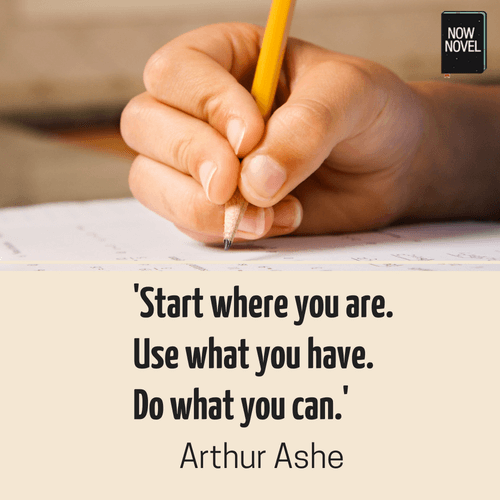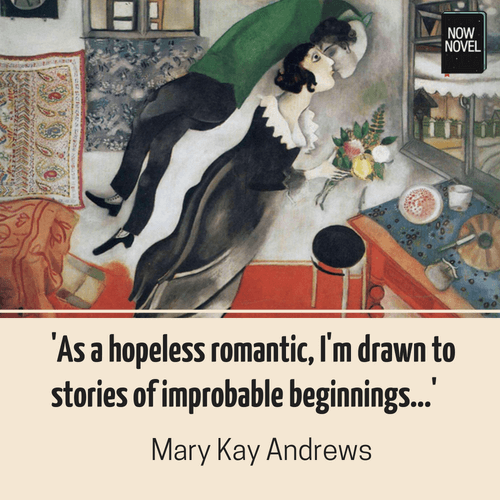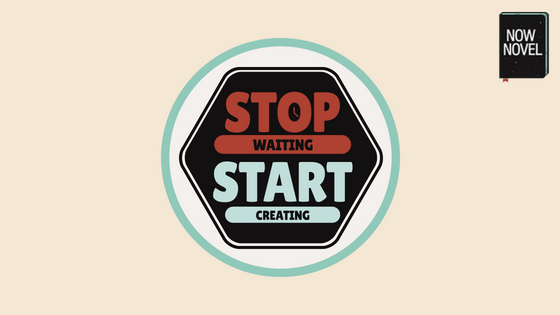The beginning sentence of a story is often what we’ll tweak last. Finding sentences to start a story is easier, after all, when you know later developments you could echo. Read 7 examples of effective opening sentences and the options they suggest for ways to begin:
1. Introduce a key character’s name (and how they got it)
Great opening lines intrigue us. They begin to form a world, yet leave enough unknowns for us to want more answers.
Sometimes, introducing a character’s name is all it takes to create this effect. Take this opening from Kazuo Ishiguro’s novel A Pale View of Hills:
‘Niki, the name we finally gave my younger daughter, is not an abbreviation; it was a compromise I reached with her father.’
What this first sentence illustrates
Ishiguro’s example illustrates finding sentences to start a story doesn’t always have to mean finding the most dramatic or explosive. The sentence intrigues us because it tells us a character’s name, while also hinting at a remaining unknown. We ask, ‘why is the name a compromise?’ Ishiguro’s simple opening makes us ask a question and this leads us on to look for the answer.
When using your first sentence to introduce a character’s name, you could include:
- How they got their name. Is it your character’s birth name or a nickname? What does this tell the reader? What unknown could you include at this stage for curiosity’s sake?
- Emotion. How does your character feel about their name? Does it have any special or emotional significance?
The above questions show that there are many possible ways to use the simple act of naming a character as an enticing opening.
2. Begin with a landmark personal or historical event
Finding sentences to start a story in characters’ backstories and histories is another good option.
Picking out a landmark, memorable event is a great way to show the experiences your characters carry with them. For example, in her beloved novel To Kill a Mockingbird, Harper Lee begins by having her narrator, Scout, remember when her brother Jem broke his elbow.
‘When he was nearly thirteen, my brother Jem got his arm badly broken at the elbow.’
Why is this opening sentence effective
The beginning is intriguing because it doesn’t give much away. How did Jem break his arm? Why is the narrator beginning with this specific event? There are enough unknowns to make this starter interesting, even though there is no clear major conflict or dilemma. It is only in the second paragraph that Scout frames the story about Jem’s arm in wider context, as she says:
‘When enough years had gone by to enable us to look back on them, we sometimes discussed the events leading to his accident.’
The story of Jem’s arm thus becomes a landmark event. It’s a memorable experience Lee uses to structure Scout’s recollection of other, equally memorable events.
This type of opening shows memory at work, as a character organizes and gathers their thoughts around key, stand-out occasions.
‘Landmark event’ opening sentences are particularly common in historical fiction. This is in part because historical fiction often explores interesting historical periods where major events were densely packed together. For example, a novel about one of the World Wars may well begin with a character describing listening to a radio broadcast about allied or enemy bombings.
This type of story opening is effective because it gives your reader:
- A sense of the ‘when’ of your setting: The story is framed from the outset around a particular event or time in your narrator’s life
- An idea of what events haunt your characters or what matters to them: Scout’s focus on others’ injuries and struggles is early indication of her compassionate nature which Lee continues to illustrate
3. Sow the seeds of your story’s world
Introducing your fictional world is another good option when finding sentences to start a book. This is particularly true for genres where world-building is a large part of the story’s magic and effect (such as fantasy and science fiction).
Consider the first line of Ursula K. Le Guin’s Earthsea trilogy:
‘The island of Gont, a single mountain that lifts its peak a mile above the storm-racked Northeast Sea, is a land famous for wizards.’
Why the world-building of Le Guin’s first sentence works
Guin’s Hemingway-like direct simplicity here gives us a single, clear image, as well as an idea of something magical or mysterious – the presence of wizards.
Yet there are still enough unknowns to create interest: Why is Gont famous for wizards? What is so renowned about them?
From starting with stark, clear imagery of the ‘where’ of her story, Le Guin spreads into character background, telling us some of her characters’ history.
For example, she moves on to sharing the origins of the dragonlord and Archmage ‘Sparrowhawk’, sharing details about his childhood on Gont’s mountain.
Putting world-building in the first sentence is a good way to anchor readers immediately in a sense of place. It’s like spreading out a map of your world on a table, for your reader to get a helpful bird’s eye view to begin.
When starting with world-building, think about:
- Unknowns you can introduce: We want to know what these famous wizards of Gont are famous for
- Concrete imagery: What’s a strong, clear image that will help your reader remember something that defines this place?
[NB: Use the ‘setting’ section of the Now Novel dashboard to brainstorm details for your story’s world].

4: Tease mystery
Some of the examples above aren’t particularly mysterious first sentences, it’s true. Le Guin’s is wonderfully direct. Yet, you could choose to begin with stronger mystery. Toni Morrison opens her hard-hitting epic about slavery, Beloved, with just three, well-chosen words:
‘124 was spiteful.’
How Toni Morrison’s first sentence creates mystery
The number here holds great mystery. It could be anything – a number given to a prisoner, a law. Instead, we learn later that it is a house number. The home is the site of a terrible tragedy affecting its occupants. The uncertainty and clipped nature of the opening sentence aptly fits the uncertainty and almost unspeakable suffering that fills the home of Sethe and her family.
When finding sentences to start a story with mystery, ask:
- What is the mystery I want to convey? Morrison’s opening effectively conveys a sense of a mysterious spite that lingers after its painful cause is removed – a haunting produced by slavery’s legacy
- How and when will I begin solving the mystery? Morrison unfolds the mystery slowly, at first saying ‘the women in the house knew it and so did the children’. By the middle of the page, we realize it is the house’s malignancy itself, the ghostly residue of the family’s trauma. Morrison describes how Sethe’s brothers ran away from home ‘as soon as merely looking in a mirror shattered it’
5. Start in the thick of action with dialogue
Many novels in genres such as thriller and crime rely on swift pace to keep us hooked. John le Carré, widely hailed as one of the great authors of spy fiction, begins his international bestseller The Spy who Came in from the Cold thus:
‘The American handed Leamas another cup of coffee and said, “Why don’t you go back and sleep? We can ring you if he shows up.”
How Le Carré’s first sentence sets up good, swift pace
Immediately we see two character’s in the middle of a tense scenario, as they await the arrival of their overdue contact. Note how Le Carré masterfully heightens the indeterminacy: The American says ‘if’ the man shows up.
Beginning with dialogue is naturally risky, as if your dialogue is confusing and your reader has nothing to anchor it to, they may be confused and frustrated more than intrigued. As Le Carre does:
- Keep it clear and simple. Note the dialogue is clearly about a specific anticipated event (the arrival of an ‘off-screen’ character), and the present characters’ options for what they do next.
- Reveal a bit about the speakers’ dynamic. From the way the American makes his suggestion as an option, it’s clear the other has at least equal authority and is free to choose what to do next. Although there isn’t much in the sentence, you can already tell this much.

6. Introduce a strong narratorial voice
The advantage of starting a story in first person is that you can introduce a strong narrator’s voice in your first sentences, a narrator who is also a player in the story.
Whether your narrator is cynical and disaffected like Salinger’s Holden in Catcher in the Rye or a butt-kicking bad-ass, a good opening first line in first person immediately ropes your reader into your narrator’s life and world view.
Take for example the opening to John Green’s bittersweet novel about teenage cancer patients, The Fault in Our Stars. The starting sentence:
‘Late in the winter of my seventeenth year, my mother decided I was depressed, presumably because I rarely left the house, spent quite a lot of time in bed, read the same book over and over, ate infrequently, and devoted quite a bit of my abundant free time to thinking about death.’
How Green’s first line establishes a strong narrator’s voice
The tone of 16-year-old Hazel comes across as arch and dry. The mother’s ‘diagnosis’ of depression seems an oversimplifying or categorizing way to describe the various ways Hazel’s behaviour reflects the real issue – her dawning reality of possible death.
This idea is expanded as Hazel continues:
‘But, in fact, depression is not a side effect of cancer. Depression is a side effect of dying (Cancer is also a side effect of dying. Almost everything is, really.)
Hazel’s voice is beautifully direct and honest, and the narrator’s voice from the opening sentence is strong. Green’s first sentence shows that a strong starting sentence introducing a narrating character:
- Reveals personality. Hazel’s tone is honest and direct. Yet there’s something archly self-aware and almost darkly comical about her tone, too. The character has a voice we can describe
- Indicates the character’s focus. It’s clear to us from the opening sentence and the subsequent paragraphs that Hazel is very much preoccupied with her condition
7. Begin with a character doing something unusual
Although when finding sentences to start a story we might reach for description first, actions make equally effective beginnings.
This is particular the case when said actions are odd, quirky, strange, creepy, suspicious or otherwise unusual. ‘Unusual’ or extraordinary actions are not ‘I sit down to breakfast’ or ‘I open my eyes, having just woken up’. These are actions most perform every day.
Instead, an unusual action is something like the first sentence of Dodie Smith’s classic novel, I Capture the Castle:
‘I am sitting in the kitchen sink.’
Why I Capture the Castle has an unusual opening action sentence
This simple action is strange enough to intrigue us to read more, kitchen sinks not being typical sitting places. The unfolding first paragraph gives us a glimpse into the character, the young, aspiring writer Cassandra:
‘That is, my feet are in it; the rest of me is on the draining-board, which I have padded with our dog’s blanket and the tea-cozy. I can’t say that I am really comfortable, and there is a depressing smell of carbolic soap, but this is the only part of the kitchen where there is any daylight left. And I have found that sitting in a place where you have never sat before can beinspiring – I wrote my very best poem while sitting on the hen-house.’
Smith takes an unusual action and expands on it to show why the character is doing what she’s doing and what it tells us about her. Smith reveals Cassandra’s adventurous spirit, her seeking out of places ‘you have never sat before’.
When starting with unusual actions, ask:
- What does this action say about my character? Does it reveal their strength, their cowardice? Their love of adventure or refusal to leave their home?
- How can I develop this action further? What more could come of this action? For example, Smith could show us other ways Cassandra works at her writing. She could show her excited response to sending a poem or manuscript to a potential publisher, for example
Trying to find sentences to start your story? Get feedback on your ideas on Now Novel, and use the Central Idea prompts to find your next great idea.


6 replies on “Finding sentences to start a story: 7 methods”
Would close third-person POV have the same effect as first person in an opening sentence? I am struggling over this one right now for my historical mystery set in Old West Nevada in 1871.
Hi Rebecca, thanks for asking. Close or limited third person does also give us the effect of seeing through a character’s eyes. Sounds like an interesting setting and time period. What specifically about your opening are you struggling with? Please feel free to share it for constructive critique in the members’ area of the site.
Thanks, Bridget. I think my confusion is that everyone says that you need a good hook. Then it is said that the author should start where the main character is in their natural environment right before the inciting incident. Then some say that you need to start in the middle of things. I am unclear as to how I would do all of these. They seem to contradict one another.
It’s a pleasure Rebecca. One of the problems with advice like that (that says what you ‘should’ do) is that it pretends there’s only one way of starting, of doing things. As the seven different approaches above indicate, there’s not one way alone. The one thing all examples do is make us ask questions though, so perhaps focus on that aspect instead – how can we increase the reader’s curiosity?
Cool! Are you going to do a post on ending sentences? I’d really like that! 🙂
Thanks, Ian! That’s a great idea. I’ll add it to our publishing calendar 🙂